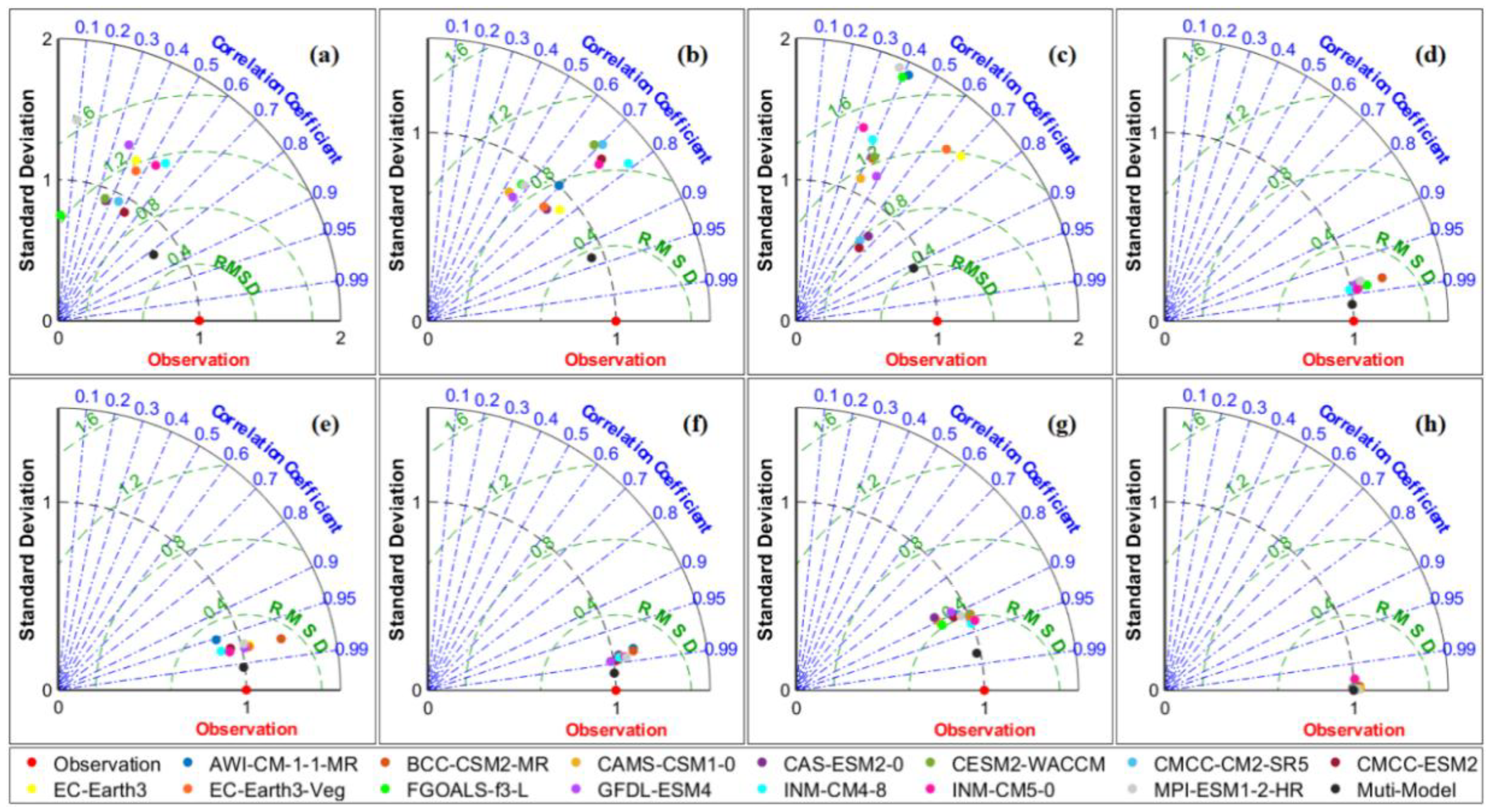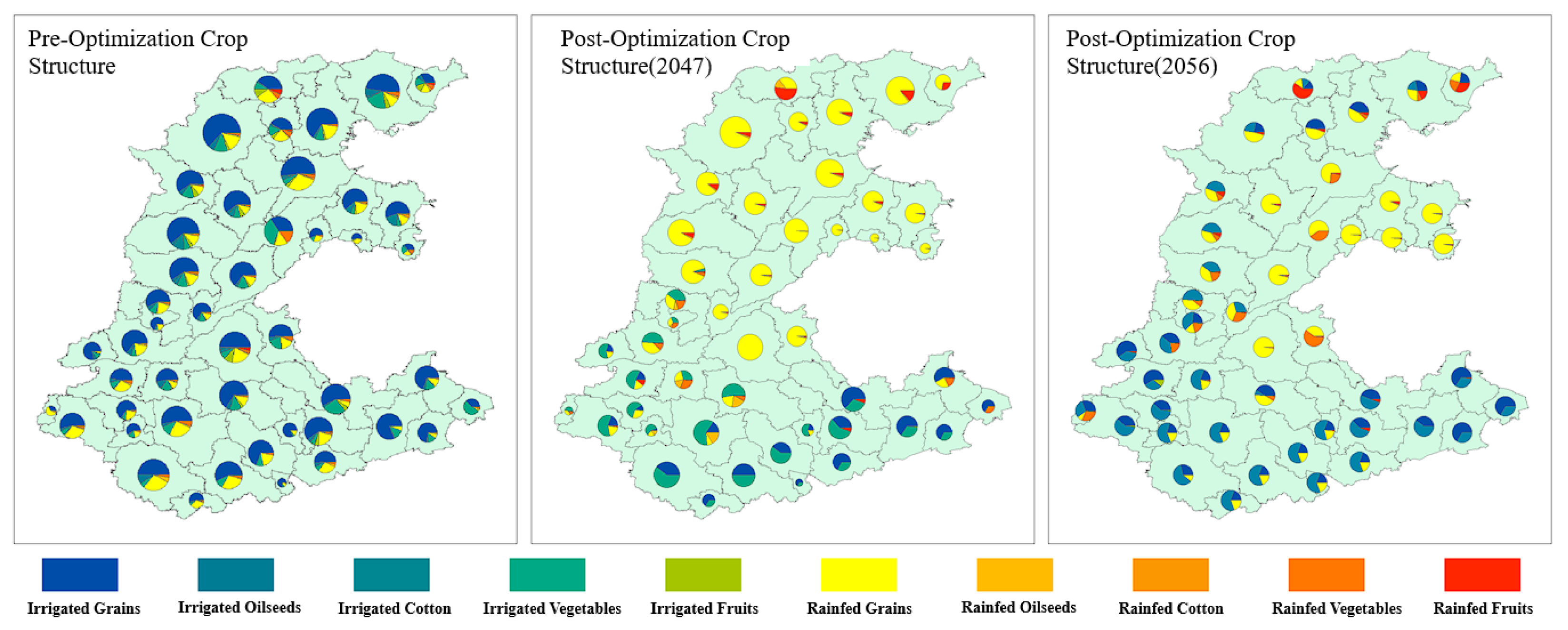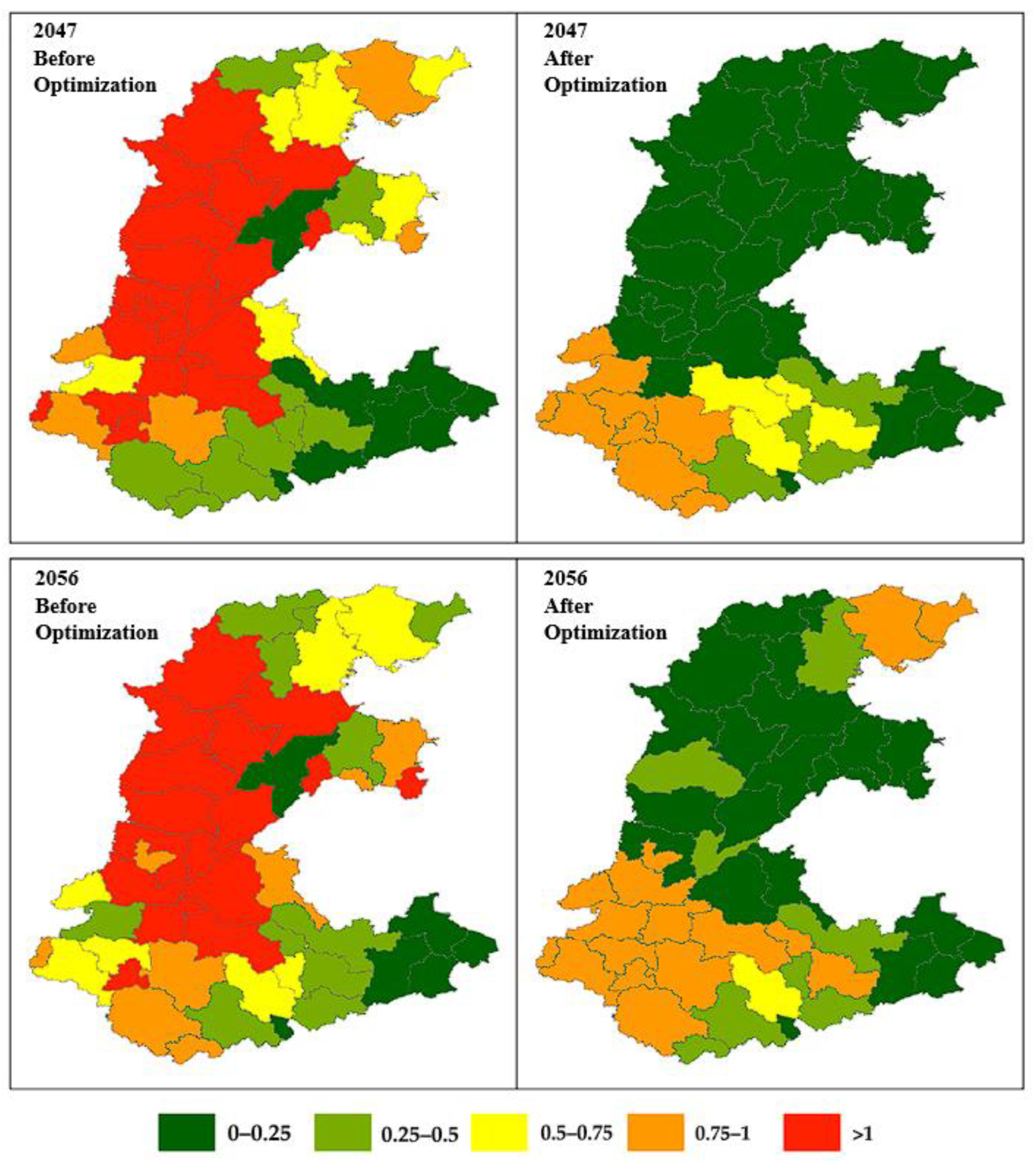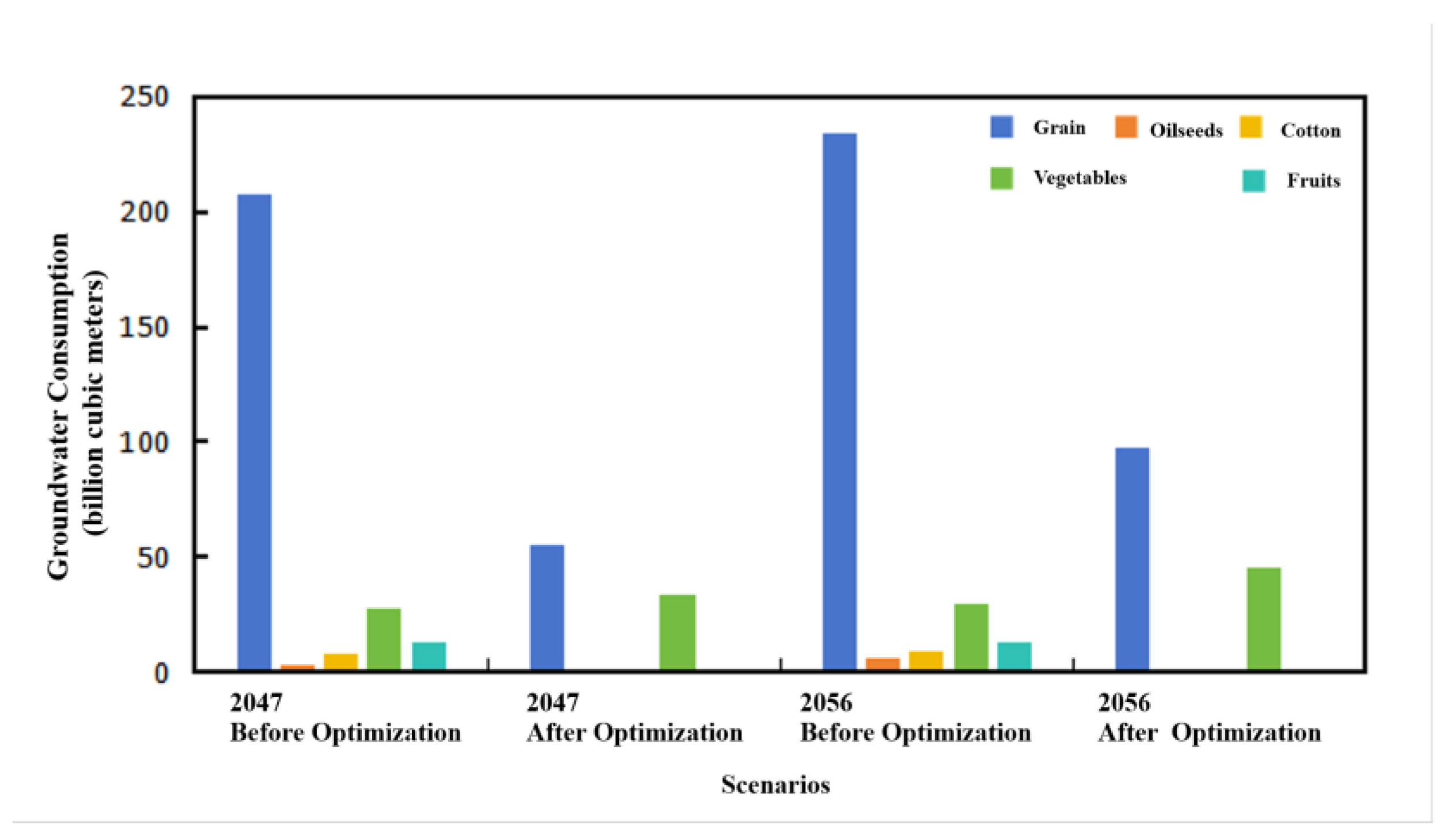1. Background
Agricultural irrigation is the primary factor driving groundwater over-extraction in the North China Plain [
1], causing significant stress on the groundwater resources. Under the conditions of climate change, key agricultural factors such as the water supply [
2], crop productivity [
3], and food demand [
4] are expected to undergo substantial changes, further complicating the groundwater issues in the region. A systematic approach is urgently needed to alleviate the groundwater resource pressure in the North China Plain while balancing water utilization, food security, and economic benefits. Optimizing the crop planting structure by integrating water resource utilization, food security, and economic efficiency offers a viable solution [
5].
Extensive studies have demonstrated that crop structure optimization can meet diverse agricultural development demands. Galan-Martin et al. optimized the allocation of irrigated and rainfed cropland, enhancing the food supply while reducing the agriculture’s environmental impact [
6]. Chen et al. adjusted the planting areas of rice, maize, and soybeans to balance the economic benefits and environmental pollution mitigation under climate change [
7]. Wang et al. combined an optimized crop structure with improved field techniques, achieving significant progress in the crop yield and environmental quality [
8]. Despite differences in perspective, the approach remains consistent—optimizing planting structure.
Traditional crop structure optimization models typically treat agricultural water use as a single unit. Some scholars have refined this by distinguishing blue water, green water, and grey water to enable more detailed analyses of water resource utilization. For instance, Zhang Lili et al. evaluated water resources from the perspective of the water footprint and analyzed the temporal and spatial changes in water resource security in the Hotan area [
9], which provided great help for water resource security decision-making. Yang Jun et al. investigated the spatial evolution characteristics and driving factors of the water footprints of major crops in the Sichuan Basin, China [
10]. Huang Li et al. calculated the water footprint and water consumption of major food crops in five Central Asian countries from 1992 to 2017 and predicted the indicators for 2042 [
11]. This study propelled the development of the water footprint from static analysis to dynamic prediction. Scholars like Ping G. et al. refined the water footprint theories and quantification methods by calculating blue, green, and grey water footprints across irrigation districts, constructing a multi-objective optimization model for planting structures under water footprint constraints [
12]. Their work introduced an integrated framework combining multi-objective water allocation and decision evaluation models, enhancing the methodologies for optimizing planting structures under quantified water footprint constraints.
However, the existing water footprint studies inadequately assess groundwater utilization in agricultural irrigation. At present, the pressure on the groundwater resources in the Huang Huai Hai region is becoming increasingly severe. It has become increasingly important to incorporate groundwater factors into the optimization systems of planting structures. In 2012, Gleeson and other scholars proposed the concept of the groundwater footprint (GWF), which quantifies the impact of groundwater extraction on ecosystems and sustainability [
13]. This is the first tool suitable for continuously evaluating the use, renewal, and ecosystem requirements of groundwater at the scale of aquifers, meaning the areas required to maintain groundwater use and the ecosystem services dependent on groundwater. Kumar et al. discussed groundwater vulnerability analysis in different methods [
14]. Goyal et al. presented the DRASTIC index (groundwater depth, net recharge, aquifer properties, soil properties, topography, seepage zone influence, and hydraulic conductivity) and compared numerical methods and index-based methods, discussing their advantages and disadvantages [
15]. They all focus on groundwater vulnerability. Despite its significance, the current GWF research faces critical limitations: (1) reliance on static threshold analyses without dynamic coupling with high-resolution remote sensing data, and (2) insufficient integration into multi-objective optimization models to support policy simulations under complex scenarios.
To address these gaps, this study develops a water–food–economy synergy optimization model that incorporates GWF and climate change projections. This study introduces the concept of the “groundwater footprint” into the field of agricultural water resource management, and introduces a new indicator that can quantitatively evaluate the demand for groundwater resources, improving the quantitative evaluation system for agricultural irrigation groundwater utilization. Constructing a multi-objective crop structure optimization model of “water–grain–economy”, while taking into account future climate change factors, provides a reference for addressing the climate change challenges and alleviating the groundwater pressure in the region. This has met the demand for relieving the groundwater pressure in the North China Plain and provided ideas for relieving groundwater pressure in other regions of the world, especially in arid areas. Evaluating the pressure on groundwater systems under climate change scenarios has strong typicality and generalizability, and aims to provide scientifically reliable and actionable decision support for the management of the overexploitation of groundwater.
2. Methodology and Data
2.1. Research Framework
The research framework is illustrated in
Figure 1, with the objective of alleviating the groundwater resource pressure in the North China Plain under climate change through crop structure optimization. The specific steps are as follows: (1) Forecasting the crop water demand, precipitation infiltration, and food demand in the study area under climate change scenarios. (2) Introducing groundwater footprint constraints to develop a multi-objective crop structure optimization model. The optimized crop structure is determined, while the historical crop structure is established based on the existing data. (3) Evaluating the stress on the groundwater system under climate change conditions by comparing the irrigation impacts using the historical crop structure and the optimized crop structure from a groundwater footprint perspective. (4) Assessing the alleviation effects of crop structure optimization on the groundwater pressure from the perspectives of crop composition and spatial layout.
2.2. Study Area and Data Sources
The North China Plain lies between 112°11′–120°19′ E longitude and 40°27′–32°8′ N latitude, spanning seven provinces and municipalities: Beijing, Tianjin, Hebei, Shandong, Henan, Anhui, and Jiangsu. It accounts for 13.7% of China’s arable land, 5.9% of its orchard land, and 2.8% of the country’s water resources, serving as a critical agricultural production base. Due to the long-term dependence on pumping fresh groundwater for irrigation, the overdraft in the North China Plain is also serious. In the northeast region of China, due to the large proportion of rice planting areas and high irrigation quota, the long-term and large-scale extraction of groundwater for irrigation has caused a serious shortage of groundwater resources. Due to the unique climate and soil conditions in the Northeast Plain, the sustainable development of water resources should prioritize optimizing the irrigation methods and improving the water use efficiency. In the North China Plain, the planting structures should be optimized according to the local conditions to ensure the sustainable development of groundwater.
The study area is divided into 46 subregions based on the administrative boundaries of the provincial-level municipalities and prefecture-level cities. Fourteen representative crops, covering over 90% of the cultivated area, are selected, including staple grains (rice, wheat, maize, soybeans), oilseeds (peanuts), cotton, vegetables (Chinese cabbage, cucumbers, tomatoes, snap beans, radishes), and fruits (apples, pears, peaches). Chinese cabbage, cucumbers, and snap beans are considered as both spring and autumn crops.
Historical meteorological data are obtained from the China Regional Ground Meteorological Dataset, the China Near-Surface Daily Temperature Dataset, and NASA CERES Data Products, while the future climate projections are sourced from 14 climate models under the CMIP6, a global climate modeling framework coordinated by the World Climate Research Programme (WCRP). The groundwater depth data are derived from the China Geological Environment Monitoring Groundwater Level Yearbook. The soil data come from the Harmonized World Soil Database (HWSD) and the Second National Soil Survey. The historical land use data are provided by GlobeLand30, while the future projections are based on the research of Chen et al. [
16]. Digital elevation data are sourced from the Shuttle Radar Topography Mission (SRTM). Crop growth cycle data are gathered from the agricultural guidelines issued by regional agricultural authorities and the study of Yang et al. [
17]. The crop coefficients are adopted from the Food and Agriculture Organization’s Irrigation and Drainage Paper No. 56 (FAO56) and the work of Aiwan Duan et al. [
18]. Data on the arable and orchard areas are obtained from the Third National Land Survey. The irrigation water source data are extracted from the Third National Agricultural Census. Crop demand and caloric data are sourced from the Food and Agriculture Organization Corporate Statistical Database (FAOSTAT). Crop economic data are obtained from the Compilation of National Agricultural Product Costs and Returns. The historical crop yield data come from the China Agricultural Yearbook, while the future yield projections are taken from FOFA 2050 Country Data. Historical GDP and population data are retrieved from World Bank Open Data, and the future GDP and population data are sourced from the SSP Database.
2.3. Groundwater Footprint
The groundwater footprint (GF) refers to the area required to sustain groundwater use and groundwater-dependent ecosystem services, essentially representing the balance between aquifer inflows and outflows. This research adopts the ratio of the groundwater footprint to the aquifer area (GF/A) as an evaluation index to assess the impacts of different crop structures on groundwater depletion under climate change scenarios in the North China Plain. The calculation follows the following formula:
where GF: groundwater footprint (km
2); A: aquifer area (km
2); C: groundwater consumption (m
3/year); R: groundwater recharge (m
3/year); and E: groundwater contribution to environmental flow (m
3/year).
The research adopts Esnault et al.’s formula for calculating specific crop groundwater footprints [
19], applying a method that allocates no groundwater for the environmental flow [
1] to estimate the agricultural groundwater footprint in each subregion of the study area, as per the following equation:
In the equation, subscript m denotes the region number corresponding to each of the 46 regions; subscript n denotes the crop number corresponding to each of the 17 crops; GFm refers to the groundwater footprint of each subregion; CIm,n (m3/year) denotes the irrigation water demand for different crops in each subregion; SIm,n (km2) signifies the irrigation area for different crops in each subregion; pm indicates the proportion of the groundwater used for irrigation within each subregion; Rm refers to the groundwater recharge of each subregion; and ηm represents the effective irrigation water utilization coefficient in each subregion.
The CropWat and WetSpass models provide CIm,n and Rm, respectively. SIm,n is determined by the 2016 irrigated areas of each crop in the North China Plain and the areas resulting from the multi-objective optimization model to respond to the climate change challenges. The proportion pm is identified by Third National Agricultural Census data. According to the “Technical Standards for Water-Saving Irrigation Projects”, ηm is set at 0.8 for the groundwater irrigation districts.
2.4. Parameter Forecasting Under Climate Change Context
2.4.1. Future Climate Data Correction
The Coupled Model Intercomparison Project Phase 6 (CMIP6) is a global climate modeling framework coordinated by the World Climate Research Programme (WCRP). It provides a standardized set of climate simulations produced by multiple international modeling centers to project future climates under various greenhouse gas concentration scenarios.
The climate data for the future stem from the CMIP6 model simulations under the SSP3-7.0 scenario, including those from AWI-CM-1-1-MR, BCC-CSM2-MR, CAMS-CSM1-0, CAS-ESM2-0, CESM2-WACCM, CMCC-CM2-SR5, CMCC-ESM2, EC-Earth3, EC-Earth3-Veg, FGOALS-f3-L, GFDL-ESM4, INM-CM4-8, INM-CM5-0, MPI-ESM1-2-HR, and others, totaling 14 models. The data are bilinearly interpolated to 0.1° × 0.1° and corrected using the Mean Drift Correction (MDC) and Multi-Model Ensemble Mean (MME) methods [
20].
2.4.2. Crop Irrigation Water Demand Forecasting
The CropWat model, developed by the Food and Agriculture Organization (FAO) in 1992 as a decision-support tool, is used for estimating the crop irrigation water demand. It calculates the reference crop evapotranspiration, crop water demand, and crop irrigation water demand.
2.4.3. Groundwater Recharge Projection
The WetSpass model is applied to estimate the precipitation infiltration recharge. WetSpass is a spatial water balance model designed to calculate the long-term average groundwater recharge based on land cover, soil texture, topography, and hydrometeorological parameters. The model uses a grid-based structure as its fundamental calculation unit. The water balance of an individual grid is computed as the sum of the independent water balances across the vegetated areas, bare land, open water, and impermeable surfaces within the grid. The total water balance for the study area is derived from the aggregation of the water balances across all grid cells [
21,
22].
2.4.4. Grain Demand Projection
Relevant studies indicate a correlation between a country’s per capita caloric food demand and its per capita GDP. This correlation provides a feasible approach for projecting future grain demand [
23]. This study establishes a model based on the historical relationship between GDP and grain demand. The future grain demand is then projected using the GDP and population data under the SSP3 scenario, provided by the SSP Database [
24].
2.5. Multi-Objective Crop Structure Optimization Model
The optimization model focuses on integrated water, food, and economic benefits. The objective functions include maximizing the crop economic benefits and minimizing the total irrigation water demand. The constraints encompass the groundwater footprint limits, food security, agricultural land area, crop category planting proportions, yield proportions within the crop categories, and non-negativity conditions. The evaluation metrics for the optimization schemes are the crop economic benefits and total irrigation water demand. The multi-objective crop structure optimization model is solved using the built-in multi-objective genetic algorithm function (gamultiobj) in Matlab [
25]. The coupled entropy-weighted TOPSIS evaluation method is employed to compare and rank the optimization schemes [
26].
2.5.1. Objective Functions
Maximizing Crop Economic Benefits: The crop economic benefits are assessed based on the crop production values. These values are derived using the producer prices of various crops and the cultivated areas and yields under both irrigated and rainfed conditions within the study area.
where subscript m refers to the region number corresponding to each of the 46 regions; subscript n denotes the crop number corresponding to each of the 17 crops; P
n represents the producer prices of different crops in 2020; SR
m,n indicates the rainfed areas of different crops in each subregion; YI
n and YR
n represent the unit area yields under irrigated and rainfed conditions, respectively; IR is the inflation rate, taken as the annual average growth rate of the national agricultural product producer price index from 1978 to 2019; and t denotes the time interval between 2020 and the research year.
Minimizing Total Irrigation Water Demand: The total irrigation water demand for the study area is calculated based on the irrigation water demand and the irrigated areas for different crops.
2.5.2. Constraints
Groundwater footprint constraint: The ratio of the groundwater footprint to the area in each subregion must be less than 1 to ensure that irrigation does not result in groundwater depletion.
Food security constraint: The caloric content provided by the grain produced in the study area must meet a proportion higher than the historical level relative to the national grain caloric demand for that year to ensure food security.
where
Caln (kcal) denotes the caloric content provided by the unit weights of the various grain crops;
kcal represents the ratio of the caloric output of grain in the study area in 2016 to the national caloric demand for grain; and
Dcal signifies the national caloric demand for grain.
Constraint on agricultural land area: It is required that the sum of the planting areas for the grain, oilseeds, cotton, and vegetables in each region during any period does not exceed the arable land area, and the planting area for fruits does not exceed the orchard area.
where subscript i denotes the period number, corresponding to six periods; x
i,n is a binary variable, taking 1 if the growth period of crop n includes period I and otherwise taking 0; S
F (km
2) denotes the arable land area of each subregion; and S
G (km
2) represents the orchard area of each subregion.
Constraint on planting proportions of main crop categories: The planting proportions of the major crop categories in each subregion must remain below an upper limit, which is set as the highest planting proportion of the major crop categories within the study area in 2020.
where subscript j represents the major crop category number, corresponding to five main categories: grain, oilseeds, cotton, vegetables, and fruits; y
j,n is a binary variable, taking 1 if crop n belongs to the major crop category j and otherwise taking 0; and Sk
j denotes the maximum planting proportions of the different major crop categories in each subregion.
Constraint on yield within major crop categories: The total yield proportion of each crop within the study area to the total yield of that major crop category is fixed based on the proportions observed in the study area in 2020.
where “Yk
n” represents the proportion of each crop yield within the research area to the total yield of that crop category.
Non-negativity constraint:
4. Conclusions
The study explores the groundwater resource pressure caused by irrigation under different crop structure scenarios in the North China Plain in the context of climate change. It provides a reference for addressing climate change challenges and alleviating groundwater stress in the region. Compared with traditional studies, this thesis introduces the concept of the groundwater footprint into a multi-objective crop structure optimization model. This ensures that irrigation does not impose severe stress on the groundwater system, meeting the needs of the North China Plain for groundwater stress mitigation while offering a practical approach for similar regions.
The North China Plain is an important grain industry base in China. However, its surface freshwater resources are scarce, and cannot meet the demand for agricultural water. A long-term reliance on groundwater extraction for irrigation has led to the severe overexploitation of the groundwater and ecological imbalance [
32]. Related studies have indicated that optimizing the allocation to rainfed and irrigated cropping areas is an effective measure to improve the groundwater resource utilization efficiency and reduce the GF of crop production in the irrigation areas [
33]. This is consistent with the conclusion of this article. The research results indicate that under the historical crop structure in the North China Plain, irrigation during dry years imposes significant stress on the overall groundwater system, with 40.87% of the region experiencing severe stress. During normal years, irrigation causes considerable stress on the groundwater system, affecting 39.02% of the region with severe stress. When adopting an optimized crop structure, irrigation in dry years results in only minor stress on the groundwater system, reducing the groundwater consumption by 66.04%. In normal years, irrigation causes low stress on the groundwater system, with the groundwater consumption decreasing by 50.79%. Galan-Martin et al. present a novel systematic method for agricultural planning in Spain. The conclusion of that study is consistent with that of this study [
6]. Previous studies have shown that under the basic premise of food crop yield, reducing the planting areas of wheat and corn and increasing cash crops can increase the economic income, ensure social equity, improve the irrigation water use efficiency, and reduce the negative environmental effects simultaneously, which is consistent with the conclusion of this study [
12]. Adjusting the crop structure and spatial layout through optimization can help the North China Plain address the challenges of climate change and alleviate groundwater resource stress. Based on the research findings, the following recommendations are proposed:
(1) Adjust Crop Variety Structure Ensuring food security is a top priority for national stability and livelihood. While reducing the irrigated area for grain, the total grain cultivation area can be expanded to increase the land resource investment, thereby reducing the groundwater consumption for grain production. Crops with low water-use efficiency, such as oilseeds and cotton, should have their cultivation areas reduced. In years and regions with abundant water resources, the irrigated area for vegetables can be moderately increased. Since rainfed farming has a minimal impact on the productivity of fruit trees, the widespread adoption of rainfed fruit tree cultivation should be promoted. Vigorously promoting rainfed planting can effectively reduce production costs. The crops mainly rely on natural precipitation, which can significantly reduce the irrigation water demand and save water and electricity costs, water pump and other tool costs, labor and other costs, and agricultural costs.
(2) Optimize Spatial Layout of Crops Based on the differences in the water and soil resource distributions in the North China Plain, implementing an appropriate irrigation ratio is an effective measure for alleviating the groundwater resource stress. The uneven distribution of precipitation resources in the North China Plain results in an increase in precipitation from north to south [
34]. In the northern part of the region, the water resource investment for agricultural irrigation should be reduced, and rainfed cropping systems should be promoted. Efforts should focus on developing drought-resistant crop varieties and improving water retention, soil moisture preservation, and rainwater harvesting techniques. In the southern part of the region, the irrigation ratio can be increased to capitalize on the advantages of the abundant water resources fully. Due to the changes in the planting structure, farmers need to adapt to new crop planting techniques and re-establish stable sales channels and processing systems. Therefore, in the early stages of this transformation, there are significant market risks. Therefore, the government needs to provide training and subsidies to strengthen the sales management under the new model in order to reduce the market risks.
(3) Strengthen Policy Support and Subsidies Reducing groundwater consumption while ensuring food security may lower the economic benefits of farming, which significantly influences farmers’ decisions. To prevent farmers from resorting to non-cooperative decisions, such as over-extracting groundwater to maintain unsustainable irrigation practices, the government should increase the subsidies for grain cultivation and rainfed farming. Promoting mechanized and large-scale agricultural production will enhance efficiency and reduce costs, ensuring that the farmers’ individual economic interests are safeguarded while pursuing broader public benefits.














